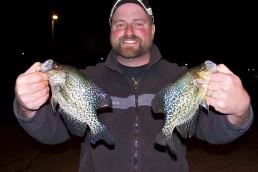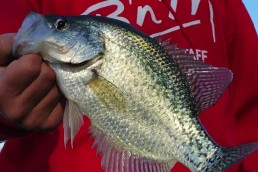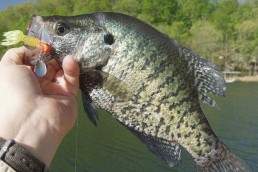Backwater Crappie Bonanza
SHARE THIS POST
It happens to me every year as we enter June. My thoughts turn from chasing the many other species of fish available on the river to focusing on the large slab crappies available to catch in the backwaters and sloughs up and down the Mississippi River.
Here in the Central and Upper Midwest, we are fortunate to have many of these locations where an angler can go out right now and enjoy some truly excellent fishing for one of the most sought-after panfish. From youngsters to seniors, the thrill of catching crappies is a sport enjoyed by many. Also, as table fare they are hard to beat.
When searching for crappies, you will want to look for deadfalls in the water close to the deepest water the backwater has to offer. This may only be 8 feet deep or so, but again, the key is the deepest water available.
When I do find the type of area that I am looking for, I’ll start out fishing it by using a long, 12-foot crappie rod and a small 64- or 32-ounce jig with a tiny plastic tail, with a tiny float attached 2 to 3 feet up on the line. With this setup, I’ll now start to check the area right in the heart of the cover. I lower the jig vertically into the cover and use a very slow lift-and-fall motion. After each lift and fall, I let the jig rest under the float; repeat the motion again after a few seconds. If crappies are there, I know pretty quickly. Always check the heart of the cover thoroughly before moving to another location. You’ll be really surprised how tight a large school of crappies can hold in thick cover.
If you do not find the fish deep inside the cover, slowly start making your way to the deeper water edges of the cover. Many times, I have found they will hold just on this deep edge and face out from the cover. Progressively keep moving, again remembering to completely work over the particular deadfall you are fishing. Also, make it a point to be as quiet as possible when exploring these areas of cover.
If you find that the crappies are not using these shallower areas to hold on, change your approach. Using your depth finder, start searching for deep-water timber stacked on the bottom. I have had success in these areas when other areas were only fair. When looking for these on your screen, try and locate where the timber rises a few feet up from the bottom. This type has proven to hold more and bigger crappies than timber that is just lying flat along the bottom.
Are you enjoying this post?
You can be among the first to get the latest info on where to go, what to use and how to use it!
Now, use one of these two very distinct approaches. The first is vertically jigging a jig and minnow rig right off the timber, the same way you would when fishing for walleyes. The slow lift and fall method seems to work best with this approach. Be sure to follow your line back down as you let the jig sink, and keep a tight line as the jig goes down or you will miss many hits. If the lift and fall method fails, try changing the speed of your motion until you find out what the fish want.
Another very deadly method that I wish more anglers would use is the slip float rig. This controlled depth method of fishing can increase your overall catch ratio; it is a simple method to learn and use. Once again, learn to work the deep wood completely. Many times you will find the fish relating to a certain area of the sunken timber. Keep this in mind when looking at your depth finder screen when searching. For equipment, I like to use a fairly soft-action rod. If you feel uncomfortable, use your choice, but don’t use a heavy-action rod. For line, I like to use a quality 6-pound-test since I am usually in snag-infested areas. If you want to go heavier, with these stained waters we have in our Midwest rivers, you can move up to an 8-pound-test, thin-diameter line without adverse effects. Also, you will be able to free more snags with the 8-pounder than with the 6. Personally, I prefer the light line and feel it works better.
Earlier I mentioned jig and minnow rigs. In regard to the minnows, try and use smaller minnows and you will have greater success. Stick with minnows in the 2-inch range, if they are available. I have caught my biggest crappies on smaller minnows. Keep your minnows fresh and lively; do not use a minnow that’s “dead” or has no action. Hook the minnow slightly through the jaw when vertical jigging, and in the back when using the slip bobber rig.
So, the next time you are out on a river like the Mississippi that has backwater areas, make it a point to go into them and enjoy some of the truly great crappie fishing that they have to offer. By being patient and using these methods, I know you will do just great. One thing is for sure—you’ll become hooked on those backwater slabs.
Email your outdoors questions to Mike Cyze at: lastcast13@yahoo.com. You can also check out his blog at: lastcastoutdoors.com or listen to him on ESPN Radio.
MWO
SHARE THIS POST
Did you enjoy this post?
You can be among the first to get the latest info on where to go, what to use and how to use it!
Mike Cyze
Mike Cyze has been called one of the most knowledgeable multispecies river anglers in the country. His ability to catch fish under the challenging conditions encountered in the river environment, combined with his overall fishing knowledge, has earned him recognition as a true Mississippi River Expert. Contact him at: lastcast13@yahoo.com.



